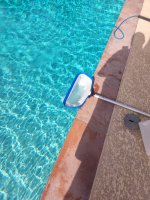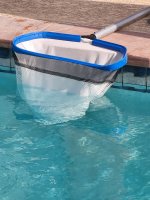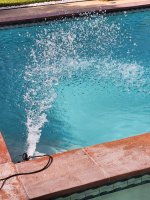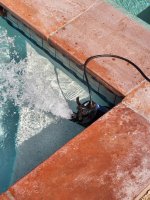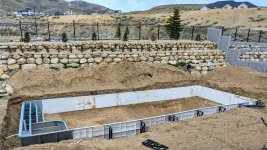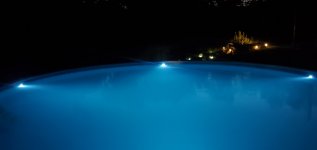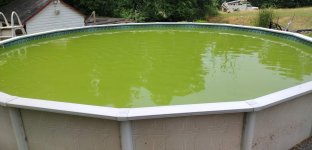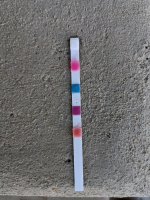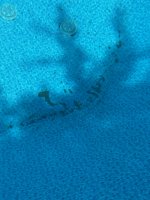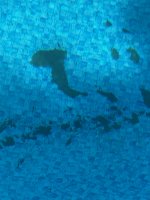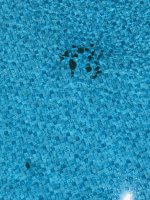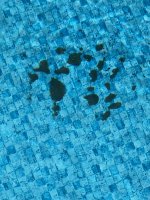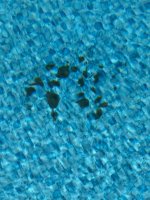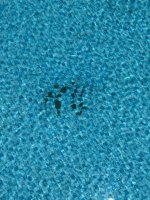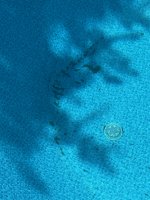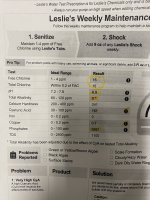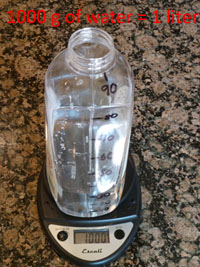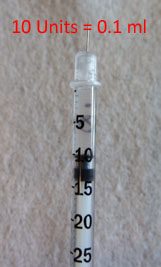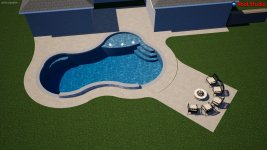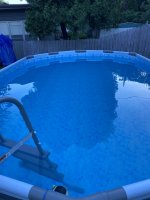This thread explores some of the ways that Cyanuric Acid (CYA) can degrade since many users report seeing CYA drop under various conditions.
CYA Degradation by Bacteria
Some pool users find that their CYA levels drop over the winter when their pool is let go (i.e. no chlorine added). Many of these pools have algae, but some do not. The degradation pathway for CYA by some bacteria and fungi (normally under anaerobic conditions) is well understood and described
here (an early article describing the degradation but incorrectly attributing urea as an intermediate is in
this paper while the correct pathway is described in
this paper). In summary, it is the following:
CYA + 2H
2O --> Biuret + H
+ + HCO
3-
Biuret + H
2O --> Allophanate
- + NH
3 + H
+
Allophanate
- + H
+ + H
2O --> 2NH
3 + 2CO
2
so the net result is:
CYA + 4H
2O --> H
+ + HCO
3- + 3NH
3 + 2CO
2
Cyanuric Acid + Water --> Hydrogen Ion + Bicarbonate Ion + Ammonia + Carbon Dioxide
For every mole of CYA, 3 moles of ammonia are produced. This is equivalent to 10 ppm CYA producing 3.26 ppm ammonia (measured as ppm Nitrogen). Sometimes the ammonia will dissipate (probably outgas or get consumed by algae) over time, but any leftover ammonia would appear as unusual chlorine demand upon opening and take a LOT of chlorine to get rid of. For every 10 ppm CYA that is degraded and produces around 3 ppm ammonia, it would take nearly 30 ppm cumulative FC to get rid of (see
this thread and
this thread). One can buy an inexpensive ammonia test kit from a pet/fish/aquarium store.
Because ammonia has an equilibrium with ammonium cation (NH
4+) with a pKa of around 9.2 in pool water (accounting for ionic strength), the net result is that the pH rises from the above reaction of CYA degradation as shown below (and the pH actually goes up even more than shown since the primary starting species is cyanurate ion):
CYA + 6H
2O --> 2OH
- + HCO
3- + 3NH
4+ + 2CO
2
Cyanuric Acid + Water --> Hydroxyl Ion + Bicarbonate Ion + Ammonium Ion + Carbon Dioxide
Some of the carbon dioxide may dissolve in the water to form carbonic acid so if that occurred completely then the following would be the result:
CYA + 6H
2O --> 3HCO
3- + 3NH
4+
Cyanuric Acid + Water --> Bicarbonate Ion + Ammonium Ion
In the above situation, the pH does not change very much, perhaps rising some since the starting species is actually cyanurate ion, not CYA as shown. The TA rises as well.
H
2CY
- + 7H
2O --> 3HCO
3- + 3NH
4+ + OH
-
Cyanurate Ion + Water --> Bicarbonate Ion + Ammonium Ion + Hydroxyl Ion
[EDIT]
This paper and
this paper describe some of the anaerobic conditions and rates for oxidation of CYA into carbon dioxide and ammonia. Under certain conditions, there are two mechanisms by which bacteria can further oxidize ammonia or ammonium ion. The first is nitrification which is an aerobic process (i.e. requiring oxygen) with two types of bacteria with the following examples shown to produce nitrate (the Nitrosomonas bacteria in the first reaction can also use ammonium ion):
Nitrosomonas Bacteria: 2NH
3 + 3O
2 --> 2NO
2- + 2H
+ + 2H
2O
Nitrobacter Bacteria: 2NO
2- + O
2 --> 2NO
3-
The second is an oxygen-limited autotrophic nitrification-denitrification (OLAND) which combines the nitrification of nitrosomonas bacteria (above) or other sources of nitrite or nitrate with subsequent denitrification under anaerobic conditions. Nitrate and nitrite are used in place of oxygen for metabolic processes. Three conditions are required for significant denitrification: low oxygen, high nitrate concentration, and a supply of organic carbon.
Pseudomonas aeruginosa is an example of denitrifying bacteria. The following are half-reactions where the other half is the oxidation of organic material.
NO
3- + 2H
+ + 2e
- --> NO
2- + H
2O
NO
2- + 2H
+ + e
- --> NO + H
2O
2NO + 2H
+ + 2e
- --> N
2O + H
2O
N
2O + 2H
+ + 2e
- --> N
2 + H
2O
There is also anaerobic ammonium oxidation (annamox) to produce nitrogen gas.
Annamox Bacteria: NH
4+ + NO
2- --> N
2(g) + 2H
2O
So each stage of bacterial degradation after the initial one to create ammonia lowers the chlorine demand as follows.
10 ppm CYA --> 3.07 ppm Ammonia nitrogen --> 24-30 ppm FC chlorine demand left to oxidize ammonia
3.07 ppm Ammonia nitrogen --> 3.07 ppm Nitrite nitrogen --> 16 ppm FC chlorine demand left to oxidize nitrite
3.07 ppm Nitrite nitrogen --> 3.07 ppm Nitrate nitrogen --> 0 ppm FC chlorine demand left
3.07 ppm Nitrite or Nitrate nitrogen --> Nitrogen gas --> 0 ppm FC chlorine demand left
So while the Nitrosomonas bacteria somewhat reduce the chlorine demand, it is the combination of that bacteria with Nitrobacter or with denitrifying bacteria or annamox bacteria that reduce the chlorine demand to zero. Of course, there will still be some chlorine demand from needing to oxidize the bacteria itself.
[END-EDIT]
CYA Degradation by Oxidation from Chlorine
Though the above can explain a loss of CYA when bacteria are allowed to grow, such as when chlorine is not added over the winter, it does not explain why some pools also experience a loss of CYA over the summer or during other times when chlorine is present and bacteria should not be growing. There is oxidation reaction of Cyanuric Acid by Hypochlorite Ion described by John A. Wojtowicz in the Journal of the Swimming Pool and Spa Industry (JSPSI) Volume 4, Number 2, pp. 23-28 (2001) reprinted in "The Chemistry and Treatment of Swimming Pool and Spa Water" in Chapter 5.3 "Oxidation of Cyanuric Acid with Hypochlorite". [EDIT] This is now available online
here. [END-EDIT]
2(HNCO)
3 + 9ClO
- ---> 3N
2 + 6CO
2 + 9Cl
- + 3H
2O
Cyanuric Acid + Hypochlorite Ion --> Nitrogen Gas + Carbon Dioxide + Chloride Ion + Water
[EDIT] On a molar basis, 4.5 chlorine oxidize 1 CYA. On a ppm basis this is 2.47 ppm FC for every 1 ppm CYA. [END-EDIT]
The primary step is the cleavage of the triazine ring and it is proposed by Wojtowicz that this primarily involves a fully chlorinated isocyanurate species Cl
2CY
-. The decomposition was first order with respect to average chlorine and increased with pH. The decomposition rate was a decrease in Free Chlorine at a rate of 0.0147 per hour or 1-EXP(-0.0147*24) = 30% per day while the calculated rate of loss of CYA at 4 ppm FC was 0.87 ppm per day [EDIT] (I get 4*0.30/2.47 = 0.49 ppm CYA per day) [END-EDIT], but that was at FC/CYA ratios (in ppm units) of 0.34 (close to shock levels) whereas the more typical ratio in our pools is around 0.1. His experiments at lower FC/CYA ratios of 0.029 with 4 ppm FC and 138 ppm CYA showed a lower CYA decomposition rate of 0.24 ppm/day which is a factor of 3.6 lower. At 4 ppm FC and 11.76 ppm CYA (a ppm ratio of 0.34), the concentration of Cl
2CY
- (at temp 85F) is a factor of 9.9 higher while HClCY
- is a factor of 6.9 higher than the concentrations at 4 ppm FC and 138 ppm CYA which might mean that HClCY
- is the rate-critical species that degrades (this is speculation on my part). In another paper "Effect of Cyanuric Acid on Swimming Pool Maintenance" (in the same JSPSI collection), Wojtowicz describes a chlorine loss rate due to oxidation of CYA at 12.5% per day at 85F which is roughly consistent with a 30%/3.6 = 8.3% rate especially since his 12.5% number came from FC levels starting higher (5.4 ppm for indoor pools, 7.6 to 9.2 ppm for outdoor pools). So, assuming a CYA loss rate of around 0.4 ppm/day in our pools this comes to 12 ppm per month which is clearly enough to be noticeable as the months pass during a swim season. If one shocks the pool, then the rate of loss could be about 2-3 times faster.
Wojtowicz also shows a strong temperature dependence on the chlorine oxidation of cynauric acid where every 10F increase in temperature results in roughly doubling the rate of degradation. So his data was with pools at 85F so pools at 90F could have degradation rates about 1.4 times higher.
The thing is that some of what Wojtowicz has seen does not seem to be consistent with some of what we have seen in our own pools, especially with regard to chlorine loss rates. Wojtowicz implies that there is little breakdown from sunlight of the chlorinated isocyanrates -- that only hypochlorous acid and especially hypochlorite ion are affected. Yet the experiments mas985 (Mark) made showed that higher levels of CYA did protect chlorine better in a non-linear way in sunlight and he did not see losses overnight (that is, without sunlight) which Wojtowicz saw in indoor pools. My own pool is at 86-90F and is exposed to sunlight 1-2 hours most days (it has an opaque electric safety cover on most of the time) and about a 1 ppm FC per day loss which includes use of the pool (1 person bather load most days). The rate of chlorine loss from oxidation of CYA is, in ppm units, about 2.5 times higher so even if I assume 1 ppm FC loss per day all oxidizing CYA, that would be 0.4 ppm CYA loss per day or 12 ppm per month. I should be able to measure that as I started with 30 ppm CYA when I opened and added more CYA around April/May. [EDIT] I just measured my pool's CYA level and it's a little above 25 ppm so even attributing a 5 ppm CYA drop over 3 months, that's pretty low and could be explained by the error tolerance of the test or some by splash-out (I have an oversized cartridge filter that is only cleaned once a year so the only dilution is from splash-out). It's certainly not near 12 ppm per month of loss. [END-EDIT]
So I can see that it is possible for CYA to degrade slowly over time in pools that are at higher temperature or at higher FC/CYA ratios such as extensive periods of shocking. The inconsistency is in how much degradation is occurring from sunlight vs. oxidation from chlorine.
CYA Degradation by Hydroxyl Radicals From Chlorine Breakdown in Sunlight
As described in
this post, when chlorine (hypochlorous acid or hypochlorite ion) breaks down in sunlight, hydroxyl radicals are produced.
This paper describes why CYA is not broken down quickly by hydroxyl radicals, but
this paper demonstrates that CYA is broken down by hydroxyl radicals (though not via titanium dioxide because adsorption is required to be close to such radical generation). So it is possible that CYA is broken down slowly in pools exposed to sunlight. Some report rates of around 10 ppm CYA per month which is higher than the roughly 2-3 ppm CYA per month seen in pools not exposed to sunlight (or the 5 ppm CYA per month seen in hot spas) which would be the degradation rate from chlorine oxidation of CYA.
Richard
